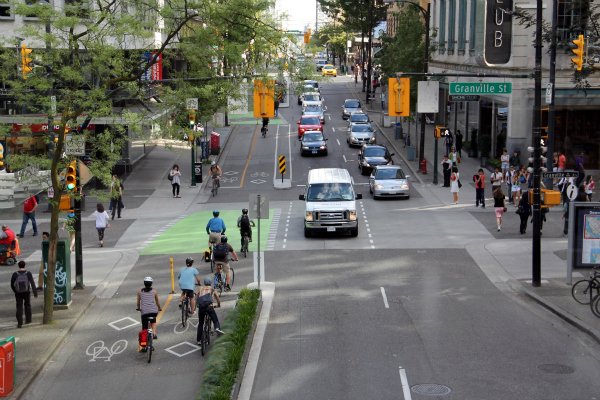Could Uptown be Waterloo's first protected bike way?
 Uptown streetscape: lots of room for improvement. (image courtesy City of Waterloo)
Do you bike through Uptown Waterloo? What if you could ride along King Street protected from traffic by a curb and parked cars?
In a few years, King Street’s pedestrian-hostile four lane thoroughfare will be a thing of the past between downtown Kitchener and Waterloo Town Square. Implementing ION will mean removing two of those lanes.
In light of this, the city of Waterloo (in partnership with the region) wants to improve King from Erb St. all the way up to University Avenue. Their plan: trim the redundant road lanes that would dead end in Uptown, and use the room to provide better access for people on foot or bike. The goal: create a friendlier, safer Uptown with space for people to move around, shop, and enjoy the scenery, while smoothing traffic flow along King. As part of this plan, the city proposes to paint traditional bike lanes of sub-standard width in between rows of parking and road lanes heavy with cars and buses.
We think they could do a lot better: instead of sandwiching cyclists between open car doors and moving traffic, why not use those parked cars to protect people on bikes? King Street may be the perfect location for Waterloo to implement its very first protected bike lanes.
 Could King Street look like this in the future? (courtesy ActiveTrans)
Protected bike lanes are paths for bikes along roads but separated from traffic by a curb, parked cars, or other barriers like planters. With as many as 60% of people interested in cycling but concerned about safety, protected bike lanes are cycling infrastructure for the rest of us. And their popularity has exploded, in places like New York, Toronto, Vancouver, Ottawa, and Montreal. Even Guelph has installed curb-protected bike lanes on part of Stone Road: providing a friendly space for bikes has greatly reduced the amount of people riding their bikes on the sidewalk.
Protected bike lanes are effective because they feel much safer for casual riders and their families. How safe are they really? One study took a look at protected bike lanes in Montreal, and found that they substantially reduce injuries while attracting riders from less bike-friendly roads. The University of British Columbia has shown that on top of being preferable, protected bike lanes get top marks for safety.
But what’s in it for Uptown? Business owners and merchants, who customarily focus on more parking to bring in customers, could stand to reap huge dividends from the presence of friendly bike infrastructure. A study of Bloor West in Toronto found that pedestrians and cyclists visit local businesses the most often and spend more money than motorists. New York created the United States’ first protected bike lanes on 9th Avenue and consequently, businesses there saw a 49% increase in retail sales. Closer to home, Waterloo’s ongoing intensification means that number of potential customers within walking and cycling distances of Uptown is growing rapidly.
Protected bike lanes are coming eventually: evidence keeps building on the benefit they can provide to our urban environment, and they’re starting to attract Waterloo’s attention. Councillor Melissa Durrell has said that she would like to see protected bike lanes and we agree with her.
This is where you come in. A good idea needs support! Visit the public consultation (and submit your feedback), and write your councillors. Tell them Waterloo needs protected bike lanes. To make cycling accessible and safe for everyone, and to keep our Uptown vibrant and healthy, we need to be heard: It’s time for protected bike lanes in Waterloo.
